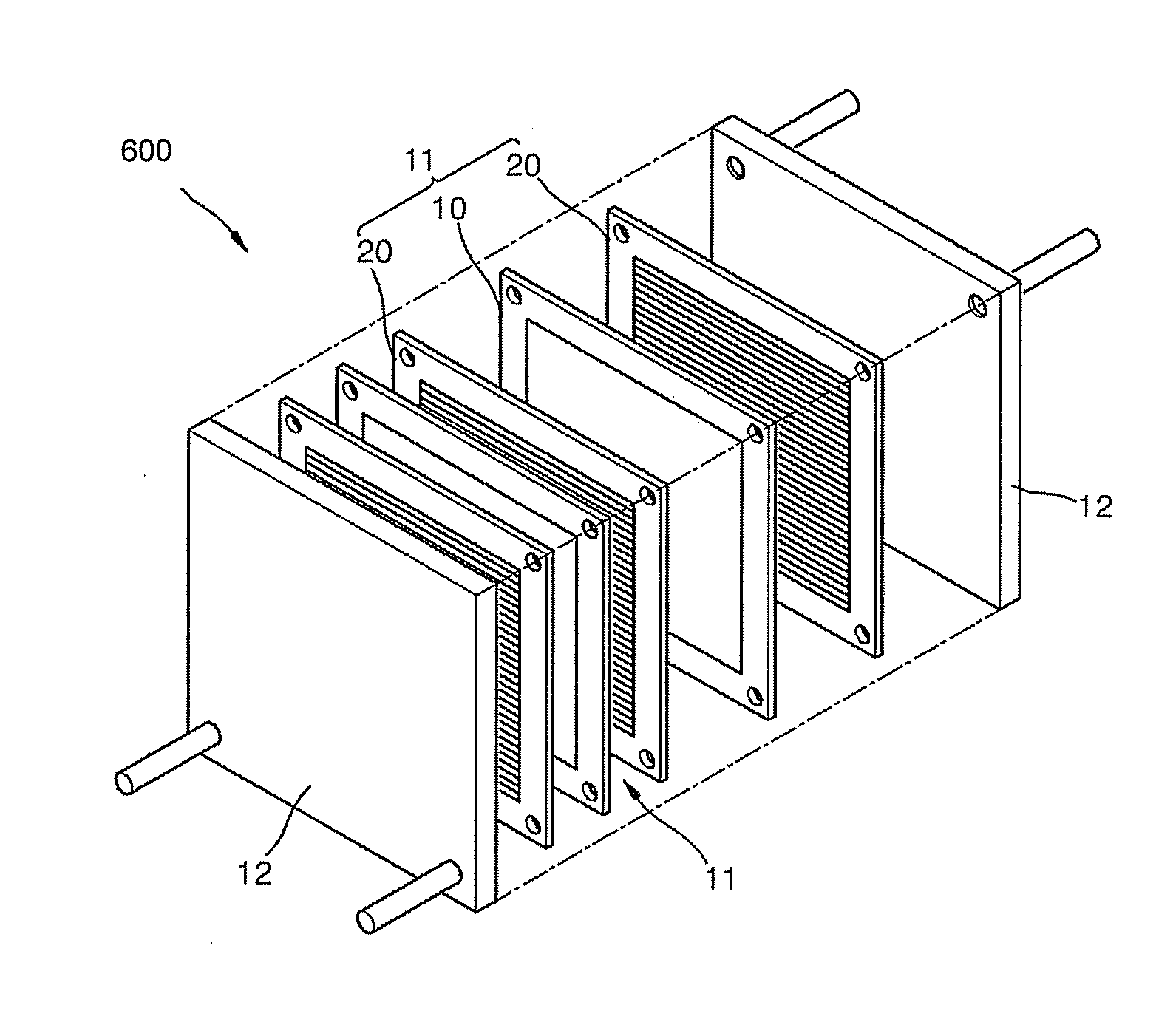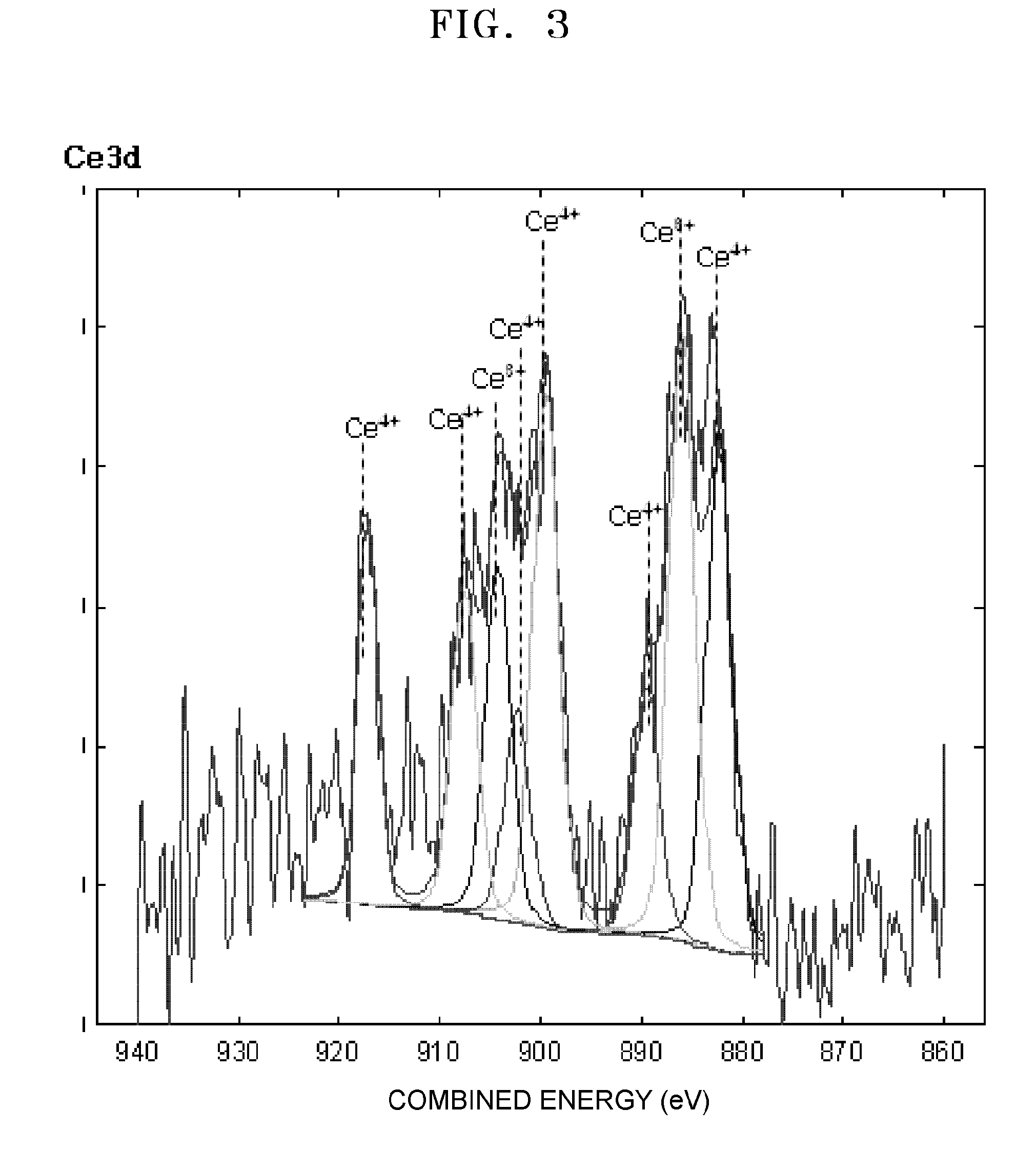Electrode catalyst for fuel cell and fuel cell including electrode having electrode catalyst
a fuel cell and electrode catalyst technology, applied in the direction of physical/chemical process catalysts, cell components, metal/metal-oxide/metal-hydroxide catalysts, etc., can solve the problems of large pt used in electrode catalysts for mass production of fuel cells, high manufacturing costs, etc., and achieve the effect of improving catalytic activity
- Summary
- Abstract
- Description
- Claims
- Application Information
AI Technical Summary
Benefits of technology
Problems solved by technology
Method used
Image
Examples
example 1
Manufacture of Pd3Co1(CeOX)1 Ternary Electrode Catalyst
[0059]0.5 g of CoCl2.6H2O as a Co precursor and 0.5 g of (NH4)2Ce(NO3)6 as a Ce precursor were added to 200 g of 1M solution of 1 g of Pd nitrate hydrate (Pd(NO3)2.XH2O) as a Pd precursor dissolved in water and then 0.5 g of Ketchen black as carbon-based catalyst support was added to the mixture solution.
[0060]In order to adjust the pH of the mixture to be basic, 1M of sodium hydroxide solution was dropwise added to the mixture solution, and stirring was performed for 12 hours to form a precipitate. The resultant precipitate was washed several times with water, and then was dried under a nitrogen atmosphere at a temperature of about 120° C.
[0061]Then, the resultant solid product was heat-treated at a temperature of about 300° C. in hydrogen gas to complete the manufacture of an electrode catalyst for a fuel cell. The mixture ratio of the metals in the resultant electrode catalyst, represented by Pd3Co1(CeOX)1, could be analyzed ...
example 2
Manufacture of Electrode and Evaluation of ORR Activity
[0067](1) Manufacture of Electrode
[0068]For each 1 g of the electrode catalyst synthesized in Example 1, 0.1 g of polyvinylidene fluoride (PVDF) and an adequate amount of NMP solvent were mixed to produce a slurry for forming a rotating disk electrode (RDE). The slurry was loaded on a glassy carbon film used as a substrate for the RDE, and then a drying process was performed in which the temperature was increased gradually from room temperature to about 150° C. to produce the RDE. The produced RDE was used as a working electrode, and the performance of the electrode catalyst was evaluated as described below.
[0069]Simultaneously, an electrode was manufactured in the same manner as described above except that the electrode catalyst manufactured in Comparative Example 1 was used.
[0070](2) Evaluation of ORR Activity
[0071]FIG. 4 is a graph illustrating the activity of oxygen reduction reaction (ORR) of the electrode catalysts of Exam...
example 3
Manufacture and Evaluation of Fuel Cells
[0075]For each 1 g of the electrode catalyst synthesized in Example 1, 0.03 g of polyvinylidene fluoride (PVDF) and an adequate amount of NMP solvent were mixed to produce a slurry for forming a cathode. The slurry for forming a cathode was coated by a bar coater on a carbon paper coated with a microporous layer, and then a drying process was performed in which the temperature was increased gradually from room temperature to about 150° C. to produce the cathode.
[0076]Separately, a general supported PtCo catalyst (Tanaka Jewelry) was used to produce an anode. A membrane-electrode assembly (MEA) was manufactured using poly(2,5-benzimidazole) doped with 85% phosphoric acid as an electrolyte membrane in between the cathode and the anode.
[0077]Then, the MEA properties were evaluated at a temperature of about 150° C. using desiccated air supplied to the cathode and desiccated hydrogen supplied to the anode.
[0078]In addition, an MEA was manufactured ...
PUM
| Property | Measurement | Unit |
|---|---|---|
| Temperature | aaaaa | aaaaa |
| Percent by mass | aaaaa | aaaaa |
| Percent by mass | aaaaa | aaaaa |
Abstract
Description
Claims
Application Information
 Login to View More
Login to View More - R&D
- Intellectual Property
- Life Sciences
- Materials
- Tech Scout
- Unparalleled Data Quality
- Higher Quality Content
- 60% Fewer Hallucinations
Browse by: Latest US Patents, China's latest patents, Technical Efficacy Thesaurus, Application Domain, Technology Topic, Popular Technical Reports.
© 2025 PatSnap. All rights reserved.Legal|Privacy policy|Modern Slavery Act Transparency Statement|Sitemap|About US| Contact US: help@patsnap.com



